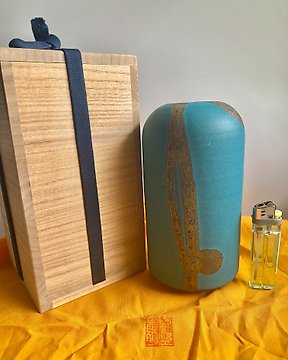
Vaas Turquoise met bronskleuraccenten - Keramiek - Morino Taimei 森野 泰明(1934年-) - Japan - Shōwa periode (1926-1989)
Nr. 85043255

Nr. 85043255

Yonezawa Soho (1897-1959)
A beautiful celadon bowl.
It has a deep color that is almost green.
米澤蘇峰 Yonezawa Soho
Born in Kanazawa in August 1897
Graduated from the Kyoto Municipal School of Arts and Crafts, Design Department in 1918
His uncle was Suwa Sozan, Imperial Household Artist
Commissioned to exhibit at the 8th Nitten Exhibition in 1952
Judge for the 9th Nitten Exhibition in 1953
Member of the Shin-Nitten Exhibition in March 1958
Judge for the Kyoto Prefectural Art Exhibition and the Kyoto Prefectural Crafts and Arts Exhibition
Director of the Kyoto Ceramic Artists Association
Permanent Director of the Kyoto Prefectural Institute of Comprehensive Crafts
Died in January 1959
The efforts to add the dark brown spots to this tea bowl are clearly visible.
The dark brown spots look casual, but their shape and placement are exquisitely balanced.
The dark brown spots are created when the glaze contains a lot of iron during the firing process.
Celadon was introduced to Japan from China in the 11th century.
Celadon with this type of iron speckle pattern is called "飛青磁Tobi seiji" in Japan, and is especially prized among tea masters.
Size
Width 12.1 cm
Height 6.1 cm
The paulownia box is dated.
The yellow cloth used at the time of purchase has a kiln mark.
I could not find any scratches or chips in my visual inspection.
Zo koop je op Catawiki
1. Ontdek iets bijzonders
2. Plaats het hoogste bod
3. Veilig betalen